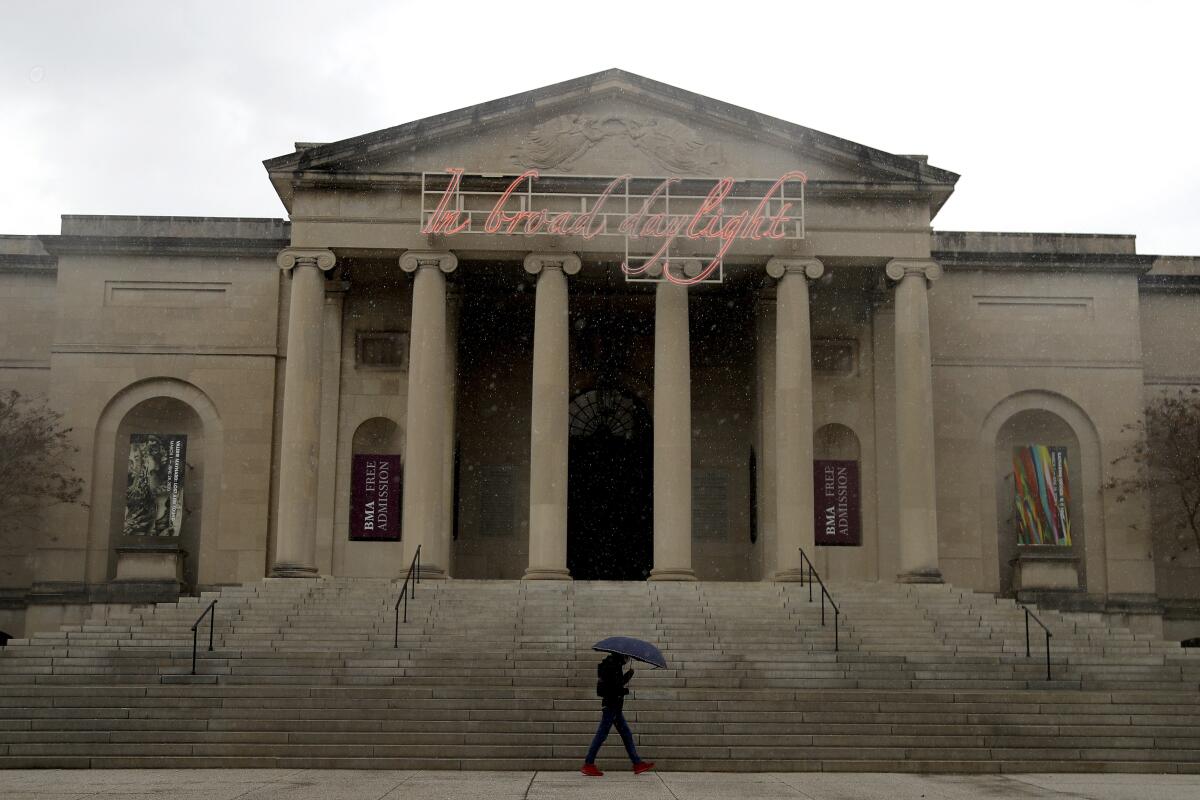Column: Dear Baltimore Museum of Art. Show me you’re serious about pay equity

- Share via
The goal was absolutely commendable: Raise the wages of the lowest-paid employees at the Baltimore Museum of Art to something resembling a livable income. Among those employees are entry-level museum guards earning $13.50 an hour in a city where almost 63% of the population is Black.
But the methods used to achieve that worthy goal were questionable.
The BMA’s idea was to auction off three high-profile works by Andy Warhol, Clyfford Still and Brice Marden, then use the gains — an estimated $65 million — to establish the Endowment for the Future, a fund that would, among other things, address wage inequities across the organization.
That plan, however, went against the spirit of deaccession rules relaxed during the pandemic by the Assn. of Art Museum Directors and unleashed a firestorm of criticism. Deaccession, as the association’s president wrote in a recent memo, was to help institutions financially affected by the COVID-19 crisis, not “for long-term needs.”
Dozens of community members, including former museum trustees, wrote a furious letter to the Maryland state attorney general. Two former board chairs, Charles Newhall III and Stiles Tuttle Colwill, rescinded planned bequests to the institution totaling $50 million.
Just hours before the paintings were set to go to auction at Sotheby’s late last month, the museum canceled the sale.
Media coverage has focused on the contretemps between BMA director Christopher Bedford and various board members, including artist trustees Adam Pendleton and Amy Sherald, who resigned in the middle of the controversy. (Both said they could not devote adequate time to the board.)
But what about those frontline workers at the heart of this story?
The goal of the BMA’s plan was and remains a noble one and should not be discarded.
As Bedford told me in an interview about museums and equity in October: “It was not defensible to make broad equity claims, do a Mark Bradford exhibition in our galleries, then pay a guard $13.50 an hour to guard these priceless works of art. That’s not the spirit of this institution.”
At $13.50 an hour, about $28,000 a year, an entry-level guard makes more than the state’s minimum wage of $11 an hour. But it’s still low enough to qualify as “very low income” within Baltimore County, according to the U.S. Department of Housing and Urban Development. It’s low enough to qualify a full-time guard at the BMA for Section 8 housing vouchers — and for that, museum officers and trustees should be embarrassed.
A fiscally robust museum plans to fund operations by selling $73 million of its art. The scope of the move threatens to accelerate a troubling trend.
Bedford’s goal was to raise employees’ pay to $20 an hour by July 2022 — for an annual salary of $42,000 a year, an actual livable wage.
Bedford’s problem was how he went about trying to attain it.
A museum’s collection is held in the public interest — think of it as a shared cultural resource — and shouldn’t be treated as an asset. Selling off works to make operational changes dips into that resource — in this case, without first reassessing budget priorities or pressing wealthy benefactors to pitch in.
It’s true that donors generally prefer splashy projects, which they can brand with their names. It’s just as true that the ways in which boards support their institutions is ripe for systemic change — since a museum charged with stewarding works by Rembrandt and Titian shouldn’t be operating on a Walmart wage model that leaves workers eligible for public assistance.
What’s curious about Bedford’s rush to sell off paintings is that the BMA actually has a good track record of raising endowment money to cover operational expenses. In 2014, before Bedford’s arrival as director in 2016, the museum wrapped up a multiyear campaign to mark its 100th anniversary that added more than $52 million to its endowment. (According to 990 forms filed with the IRS in 2018, the most recent year available, that endowment now stands at approximately $118 million.)
In addition, despite the recent controversies, it appears that the museum has not entirely scared off donor largesse: This week, filmmaker John Waters announced that he’ll be donating his personal collection of 372 works by 125 artists to the museum.
The Baltimore Museum of Art reversed its decision to sell artworks from the permanent collection hours before two were to be auctioned at Sotheby’s.
Former board chair Colwill, who stepped down as an honorary trustee as a result of the deaccession controversy, helped lead the endowment initiative. To fix museum guard salaries, “the solution is simply raising more endowment money,” he says, “and to do that you have to ask.”
It’s also a matter of institutional priorities, he notes. “Maybe you don’t have as many exhibitions rapid-fire and you put some of that money toward the guards’ salary and raising salaries across the board.”
Newhall, another former board chair who also resigned his honorary position, says to reconcile the wages of guards, the best course of action might have been to start with some data.
“You have a study of how much guards make,” he says. “If you are in the low quartile, you try to move up to the middle of the road. You present a budget and, if you are short of money, you go out and raise it.”
Of course, comparing guard salaries to other guard salaries may not necessarily help BMA workers — since wages for museum guards are generally substandard.
Much more than simply increasing diversity, the task ahead will consist of rethinking the very ways in which museums are governed.
Around the country, visitor services associates and other frontline workers have staged labor battles over salaries that barely hover above the minimum wage in cities with skyrocketing living costs. This includes institutions such as the New Museum and the Guggenheim in New York and the Museum of Contemporary Art in Los Angeles. (The Marciano Art Foundation, quite famously, shut down in the wake of a unionization attempt.)
The goal, ideally, should be to pay workers a livable wage — not a less bad one than the museum down the road.
How and whether the BMA will continue to pursue this worthwhile goal is unknown at the moment. (At this point, the internal fallout could spell an end to meaningful changes of any sort.)
Neither Bedford nor any other officers or trustees were available for comment. A spokeswoman, however, did state via email, “The BMA is currently working through its plans to achieve the goals laid out as part of its Endowment for the Future and we are holding on further interviews until there is new information and more content to share.”
The BMA is hardly the only museum with stark pay-equity problems in its lower ranks. But its attention to the issue has set it apart from countless other institutions that have largely ignored the issue. For the sake of the museum’s service workers — and service workers everywhere — here’s hoping they figure it out.
More to Read
The biggest entertainment stories
Get our big stories about Hollywood, film, television, music, arts, culture and more right in your inbox as soon as they publish.
You may occasionally receive promotional content from the Los Angeles Times.












